Are you passionate about photography and looking for ways to monetize your work? Selling photos online is a fantastic way to generate income, whether you’re a seasoned professional or just starting out. The internet offers a vast marketplace where your images can reach a global audience, from individuals and small businesses to large corporations. This guide will walk you through everything you need to know about How To Sell Photos Online, from choosing the right platforms to optimizing your portfolio and understanding the legal aspects.
Top Platforms for Selling Photos Online
The digital landscape is rich with platforms designed to connect photographers with buyers. Each platform offers unique features, commission structures, and target audiences. Here are 15 of the best websites where you can sell your photos online:
1. Alamy
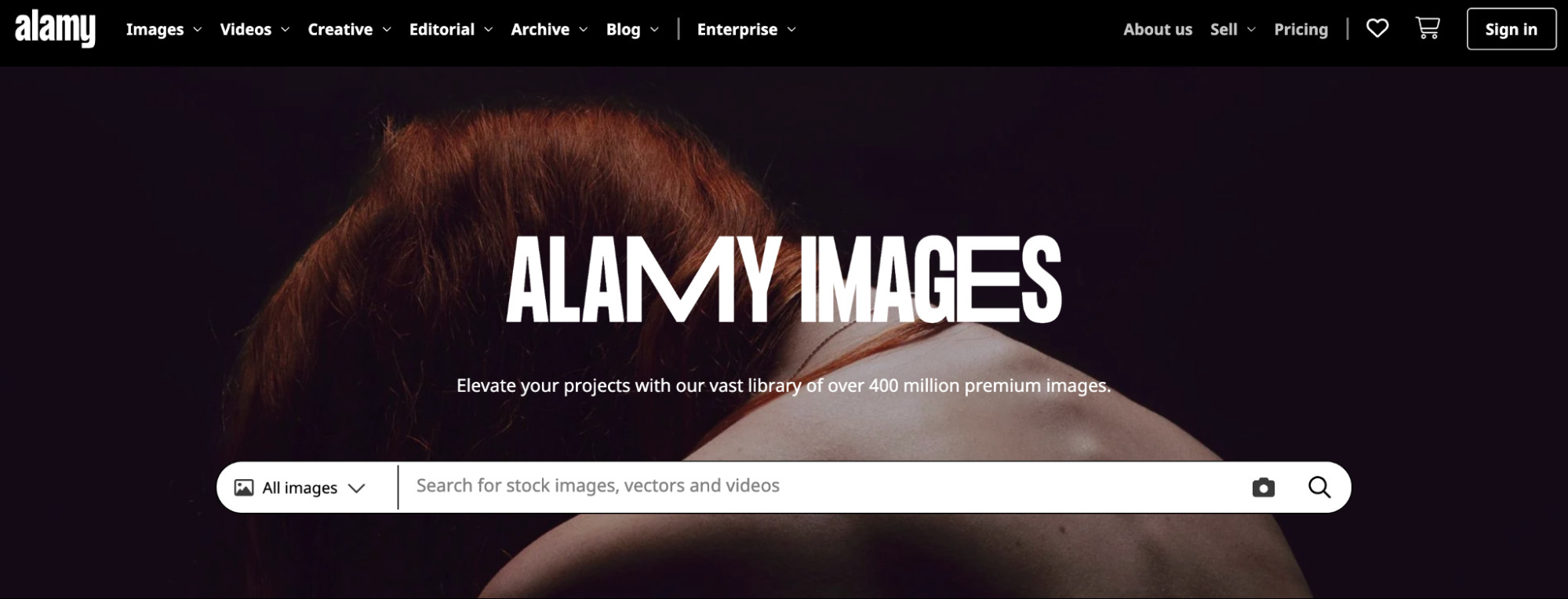 A diverse stock photo collection on Alamy's homepage.
A diverse stock photo collection on Alamy's homepage.
Alamy boasts one of the most diverse stock photo collections online, featuring millions of images, vectors, videos, and panoramic shots. This platform is ideal for photographers seeking broad exposure and a varied customer base. Alamy also provides the Stockimo iOS app, enabling you to sell photos directly from your smartphone.
Payment Structure
Alamy offers monthly payments and various commission models, ranging from 17% to 50% of sales. The commission percentage depends on image popularity and license type. There are no long-term contracts, and payments can be made in multiple currencies.
2. 500px
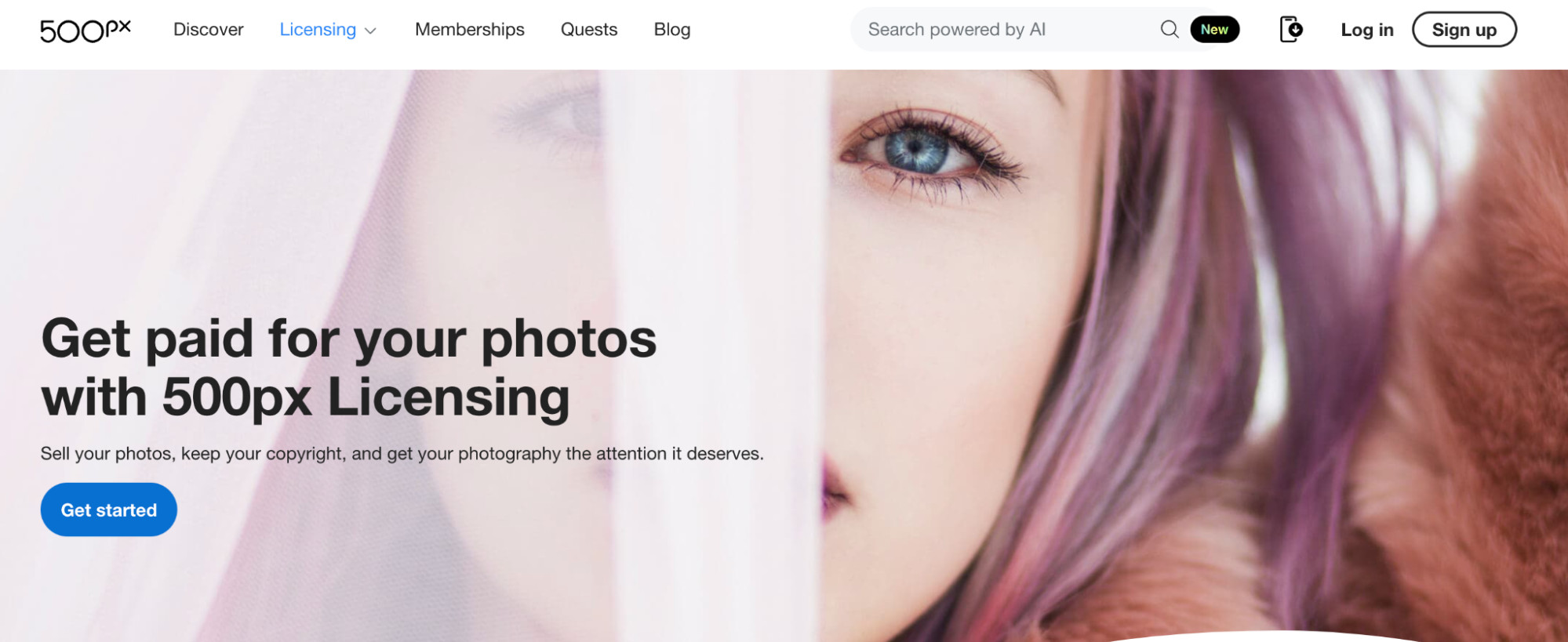 500px homepage showcasing licensing opportunities for photographers.
500px homepage showcasing licensing opportunities for photographers.
500px blends stock photo licensing with a thriving photographer community. Millions of photographers use 500px to sell and license their work. The platform’s Pulse algorithm helps surface new talent, providing opportunities for emerging photographers to gain visibility, provided their photos meet quality standards. Beyond selling, 500px offers community features, feedback opportunities, and photography competitions.
Payment Structure
Paying members on 500px can earn up to 100% royalties on exclusive photos, making it a potentially lucrative option for dedicated contributors.
3. Shutterstock
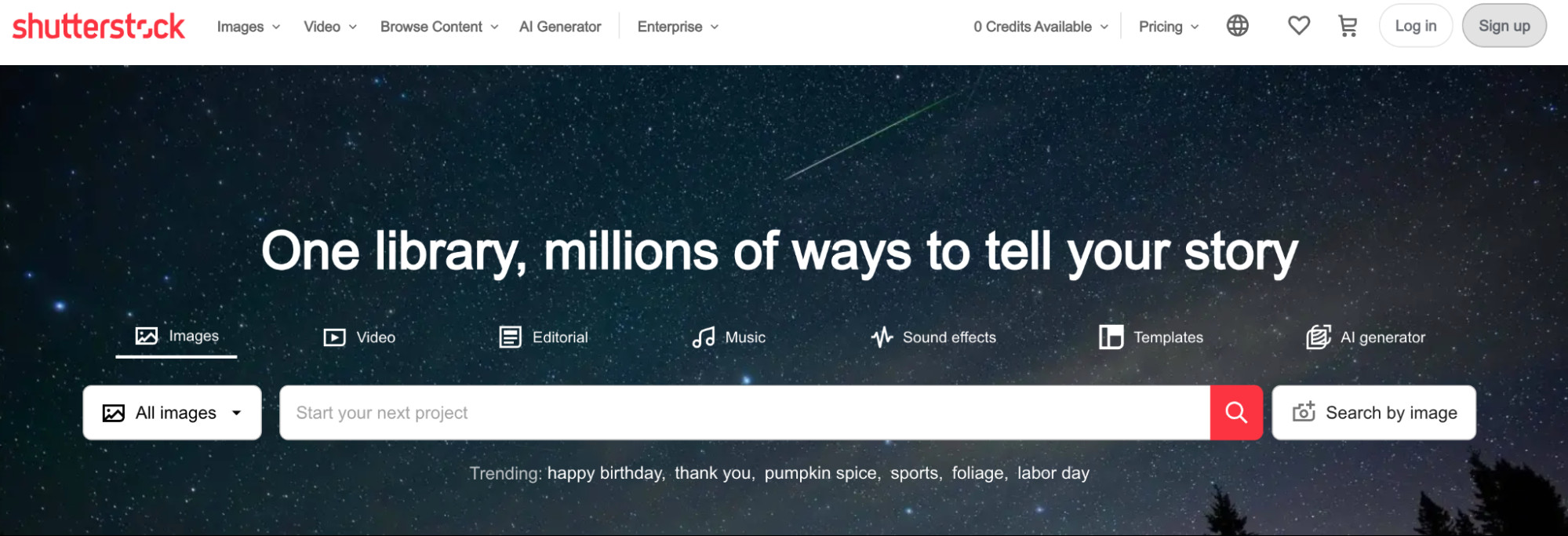 Shutterstock's royalty-free image and media search interface.
Shutterstock's royalty-free image and media search interface.
Shutterstock stands as one of the most recognized stock photography websites globally. It’s a micro-stock site, meaning photos are typically priced lower and are often non-exclusive. Shutterstock has paid out over $1 billion to its contributors, highlighting its scale and market reach. While individual image earnings might be lower, the high volume of downloads can lead to substantial income, making it a great starting point for those learning how to sell stock photos online.
Payment Structure
Contributor payouts on Shutterstock range from 15% to 40%, based on lifetime earnings. They also have an affiliate program for additional income through referrals.
4. Getty Images
 Getty Images website with a prominent search bar for stock images.
Getty Images website with a prominent search bar for stock images.
Getty Images is renowned for its premium stock photo library. It attracts high-end brands and publishers seeking exclusive, high-quality, and often hard-to-find images. Getty Images, including its microstock subsidiary iStock, reaches over 1.5 million customers worldwide. Getty Images maintains strict quality standards for photographers, ensuring a premium collection.
Payment Structure
To become a Getty Images contributor, you need to apply with a portfolio of sample photos. Once accepted, you can earn between 15% and 45% of the image license fee.
5. iStock
 iStock's landing page featuring a generative AI image creator.
iStock's landing page featuring a generative AI image creator.
iStock, by Getty Images, offers a non-exclusive option for contributors. The key difference from Getty Images is that iStock allows non-exclusive photos, meaning you can sell the same images on other platforms, offering greater flexibility.
Payment Structure
Similar to Getty Images, you need to apply to become an iStock contributor. Commissions range from 15% to 45%, based on your contributor agreement.
6. Stocksy
 Stocksy homepage with a stylized image of people in a library.
Stocksy homepage with a stylized image of people in a library.
Stocksy is known for its high payouts and artist-owned cooperative model. Photographers on Stocksy can earn a 50% royalty on standard licenses and 75% on extended licenses. Exclusivity is required for all photos on the platform. As a cooperative, Stocksy contributors can receive profit-sharing, offering a unique benefit.
Payment Structure
Stocksy pays contributors monthly via PayPal, Payoneer, or check, with a minimum payout of $100.
7. Picfair
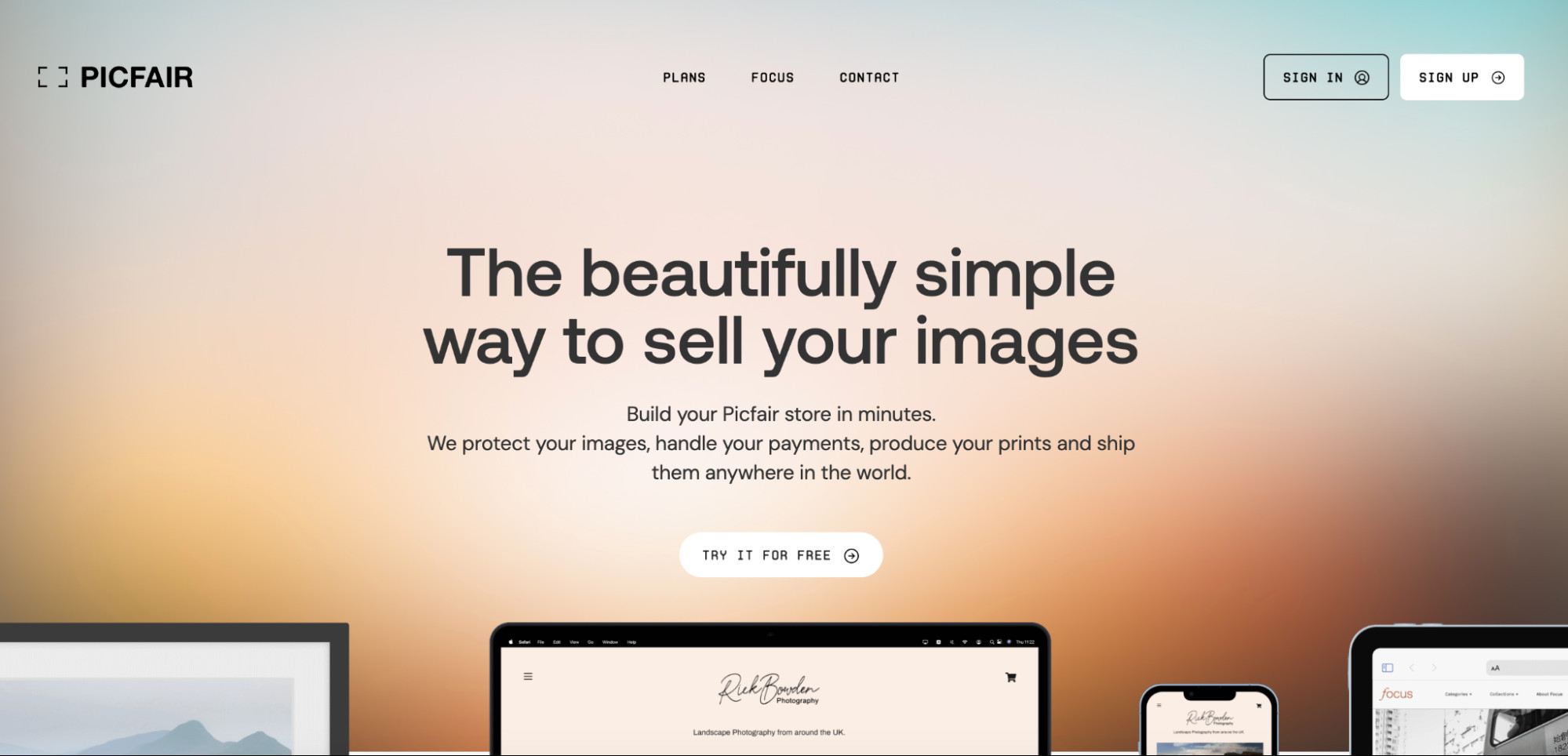 Picfair's website builder landing page tailored for photographers.
Picfair's website builder landing page tailored for photographers.
Picfair provides photographers with more control over their online presence by enabling them to create their own photography e-commerce websites. You set your own prices for both prints and digital downloads, and Picfair handles payment processing, print production, shipping, and digital image licenses.
Payment Structure
Picfair operates on a subscription model. The Plus plan, priced at $5 per month (billed annually), allows you to create a custom store with up to 10,000 images for sale as prints or downloads.
8. Adobe Stock
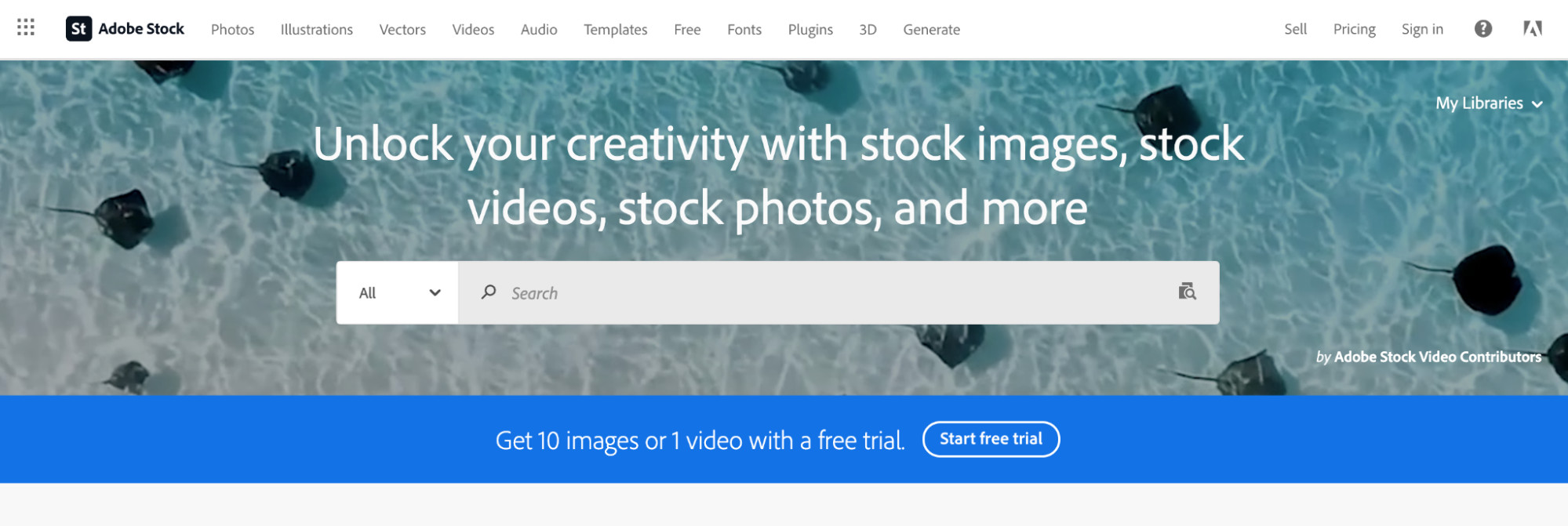 Adobe Stock's search interface against an underwater stingray photo.
Adobe Stock's search interface against an underwater stingray photo.
Adobe Stock seamlessly integrates with Adobe’s creative software suite. If you’re an Adobe user, you can directly upload your images, videos, vectors, and illustrations to Adobe Stock. This integration streamlines the process for photographers already using Adobe products.
Payment Structure
Contributors who link their Adobe ID to Adobe Stock earn 33% royalties on photos and 35% on videos. Direct uploads from Lightroom and Bridge enhance workflow efficiency.
9. Envato Elements
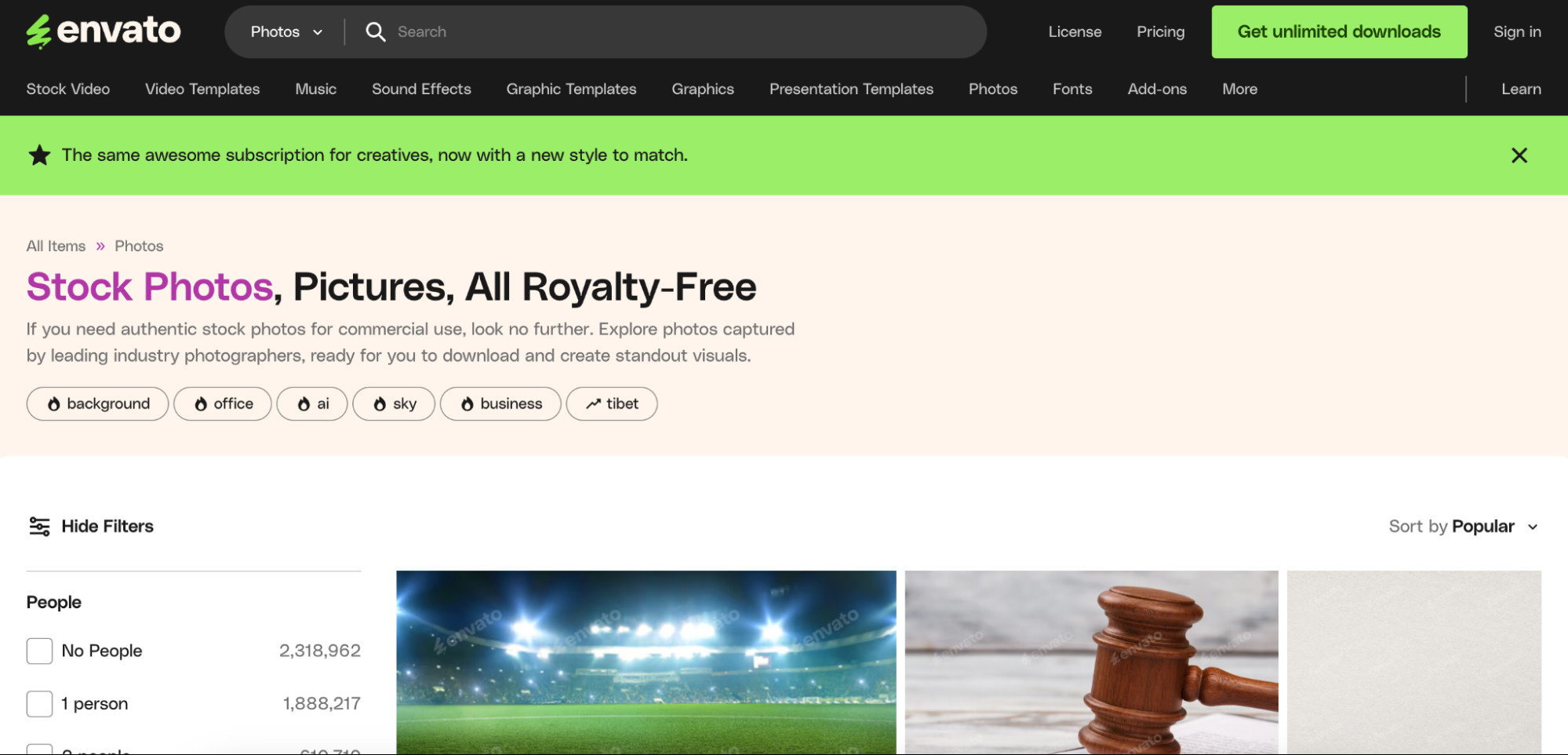 Envato Elements stock photo landing page.
Envato Elements stock photo landing page.
Envato Elements offers a subscription-based model, allowing you to share in the total subscriber revenue. You can sell photos on their platform or embed photos from Envato Elements on your own website. It’s a popular platform for photographers looking to diversify their income streams.
Payment Structure
Envato Elements contributors earn between 25% and 50% of the net subscription revenue, providing a share in the platform’s overall success.
10. Unsplash+
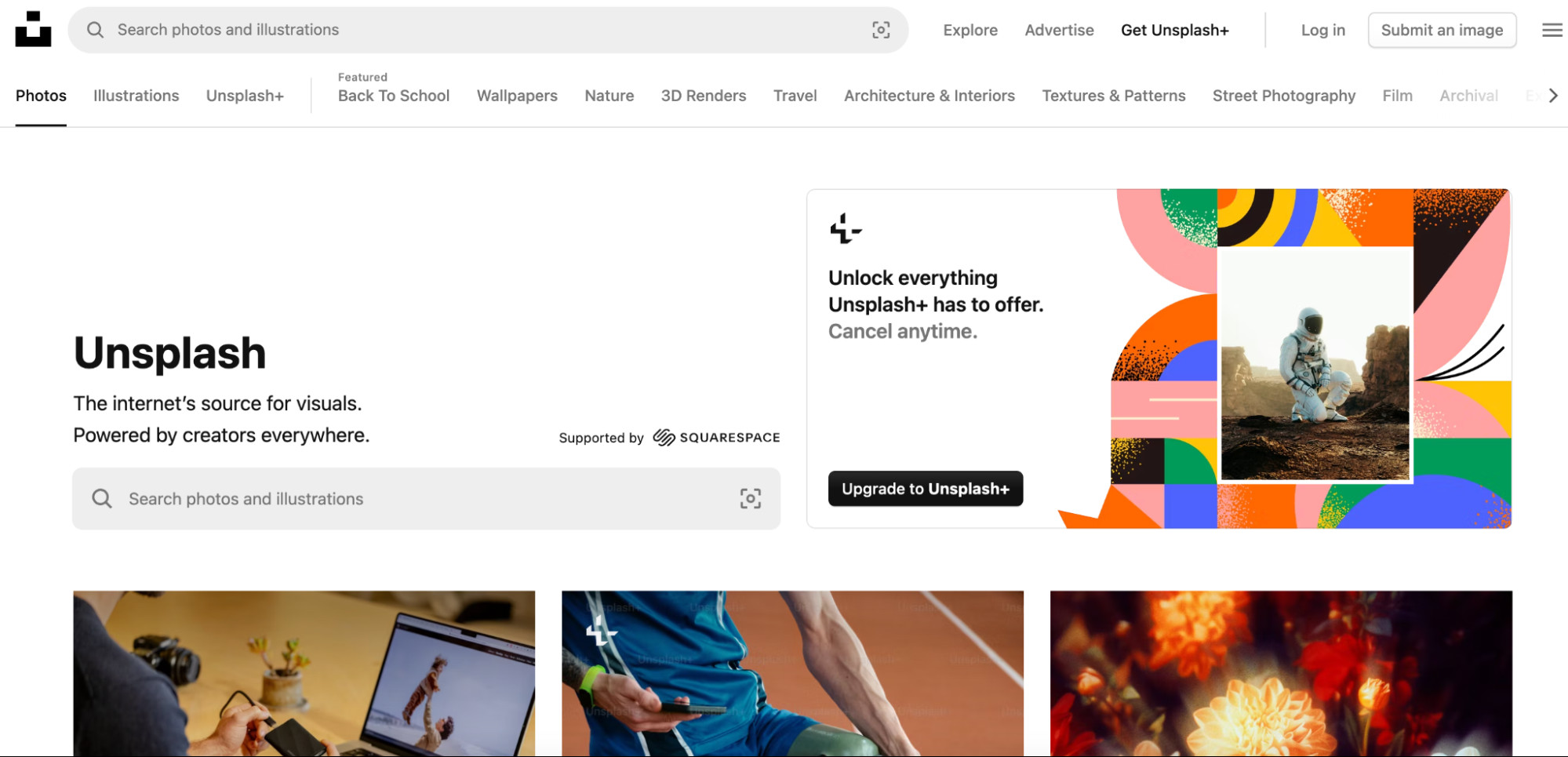 Unsplash homepage showcasing stock photos and a call-to-action.
Unsplash homepage showcasing stock photos and a call-to-action.
Unsplash+ (part of Getty Images) takes a different approach by paying photographers for image submissions based on assignments rather than sales. Through the Unsplash+ program, photographers respond to specific briefs and requests from clients.
Payment Structure
Once accepted into Unsplash+, you gain access to briefs from Unsplash customers. Payment rates range from $5 to $30 per accepted image, offering a predictable income for fulfilling specific needs.
11. Dreamstime
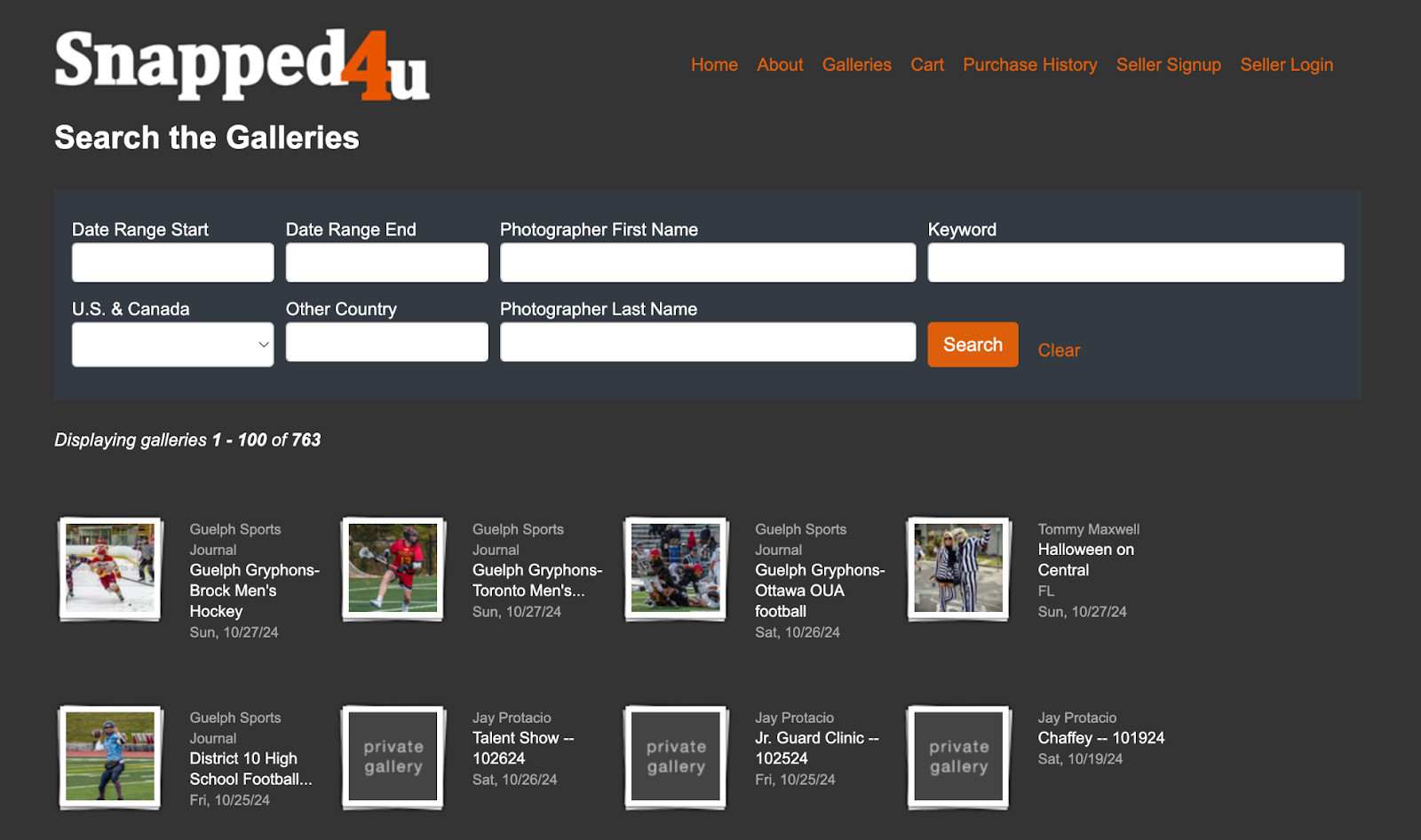 Dreamstime's microstock library homepage.
Dreamstime's microstock library homepage.
Dreamstime is a large microstock platform with over 250 million royalty-free media files. It offers a wide range of media types, including photos, vectors, videos, and audio. With a large user base, Dreamstime provides access to a significant audience.
Payment Structure
Dreamstime offers revenue sharing from 25% to 50% for non-exclusive content. Exclusive contributors earn a higher percentage and receive additional compensation per submission. They also feature an affiliate program for added earnings.
12. Snapped4U
 Dreamstime's microstock library homepage.
Dreamstime's microstock library homepage.
Snapped4U specializes in event and portrait photography. It’s designed for photographers who sell directly to clients from events or portrait sessions. Photographers can create personalized galleries and set their own prices (up to $20 per image). Note that Snapped4U is not suited for landscape or still-life photography.
Payment Structure
Snapped4U charges a one-time registration fee and takes a 10% to 12% commission on sales. Photographers are paid via PayPal twice a month.
13. Foap
 Foap creator landing page promoting a mobile app for photographers.
Foap creator landing page promoting a mobile app for photographers.
Foap allows photographers to sell commercial-quality images directly to brands and individuals. A key feature of Foap is “missions,” where brands specify photo or video needs and reward winning submissions. Foap has paid out millions to creators, making it a viable income source.
Payment Structure
Mission payouts on Foap range from $100 to $2,000. For individual photo sales on the Foap market, Foap takes a 50% commission.
14. EyeEm
 EyeEm homepage showcasing high-profile client logos.
EyeEm homepage showcasing high-profile client logos.
EyeEm combines a photo marketplace with a photographer community. Like Foap, EyeEm uses “missions” where photographers can submit images based on specific themes. EyeEm also focuses on community building and feedback.
Payment Structure
EyeEm contributors earn a 50% commission on sales through their marketplace. Payments are made via PayPal.
15. Pond5 (for Videos)
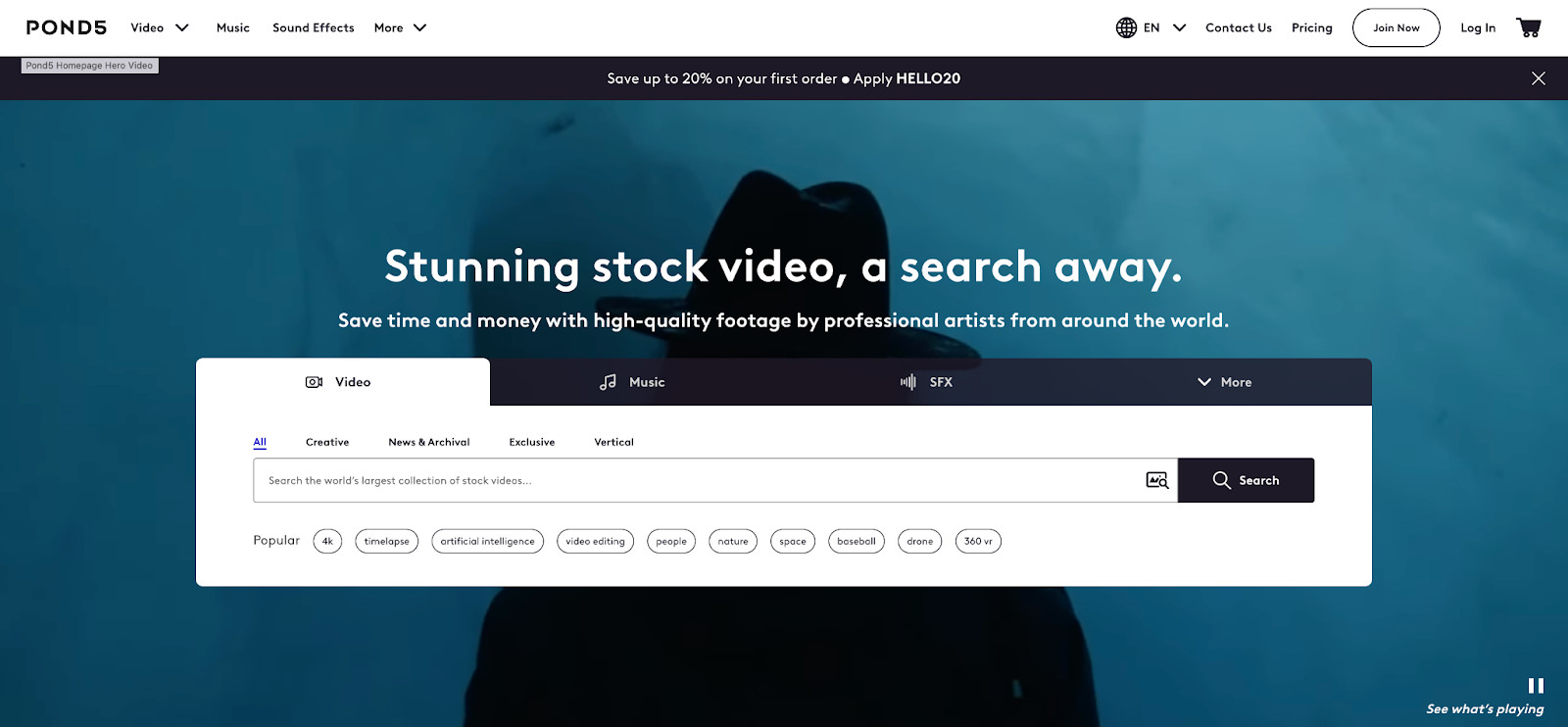 Pond5 homepage for royalty-free video and media assets.
Pond5 homepage for royalty-free video and media assets.
Pond5 is specifically for selling royalty-free videos, music, sound effects, and other media assets. It’s frequented by major clients like the BBC and Disney. If you’re a videographer, Pond5 offers a significant platform to sell your content.
Payment Structure
Pond5 offers a 40% royalty share, with an option to earn up to 60% for exclusive content. They also have a referral program for additional income.
Key Tips for Successfully Selling Photos Online
Building a thriving online photo selling business requires more than just uploading images. Here are essential tips to maximize your success:
Define Your Photography Niche
Consistency is crucial. Whether you specialize in travel, portraits, food, or nature, developing a recognizable style and focusing on a niche helps you attract a target audience. Explore subjects and styles you enjoy shooting that also resonate with buyers. Keyword research tools and Google Trends can help you analyze demand for different image topics.
Leverage Instagram and Social Media
Social media, especially visual platforms like Instagram, is vital for reaching a broad audience. Use Instagram tools to engage with relevant hashtags, connect with potential clients, and grow your following. Linking social media accounts simplifies sharing and boosts your online visibility.
Integrate E-commerce into Your Website
Having your own website to showcase your portfolio is essential. By integrating e-commerce functionality, such as a Shopify Buy Button, you can directly sell stock images, prints, or other products from your site. This provides greater control and branding opportunities.
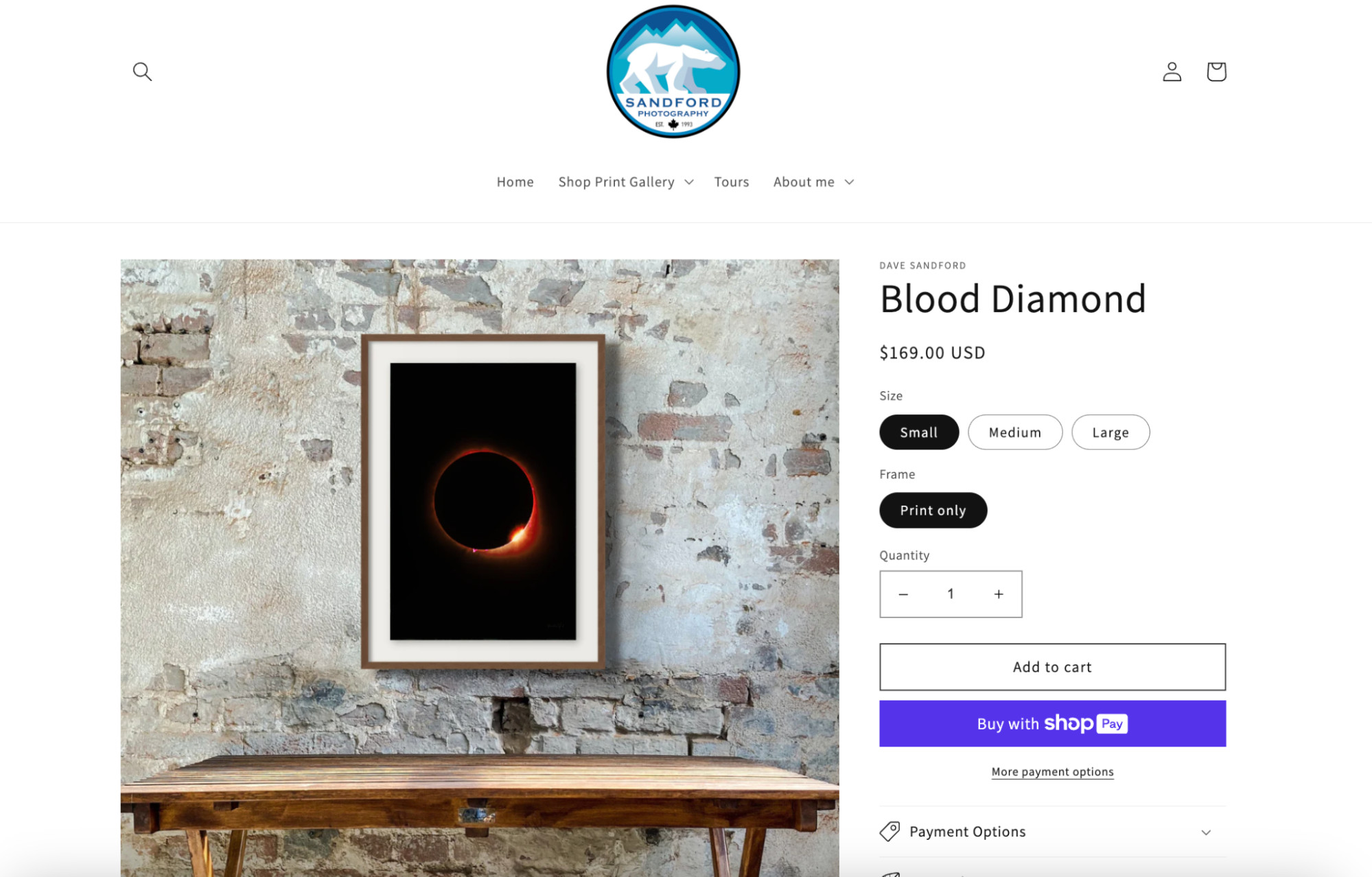 Ecommerce product page example for a moon print.
Ecommerce product page example for a moon print.
Consider using pre-designed photography themes or gallery apps to set up your online store quickly and professionally.
Understand Your Target Market
Knowing your target market is paramount. Identify who is most likely to purchase your photos. For example, if you shoot wedding photos, your target market for stock images is likely wedding industry suppliers, not couples. Understanding your buyer persona helps you tailor your photos to meet their needs and preferences.
Setting Up Your Online Photography Portfolio: Step-by-Step
Creating an effective online portfolio is essential for showcasing your work and attracting buyers. Follow these steps to build a compelling portfolio:
1. Choose the Right Platform for Your Portfolio
The best platform depends on your goals and desired level of control.
- For hobbyists or passive income seekers: Stock photo submission sites like iStock or Alamy are ideal.
- For brand assignments: Unsplash+ offers opportunities to get briefs without direct pitching.
- For full control over your business: E-commerce platforms like Shopify provide complete control over your brand and sales.
2. Plan Your Portfolio’s Structure and Design
Your portfolio is your visual resume. Consider these key elements:
- Layout: Prioritize visuals but add context with mini descriptions for each image. This aids both user experience and SEO.
- Social Proof: Include testimonials or examples of how your images have been used to build credibility.
- Categories and Organization: Use tags and categories to make browsing easy. Organize by theme, location, subject, or date.
- Gallery Size: Curate your best work. Limit galleries to high-quality images that showcase your strengths.
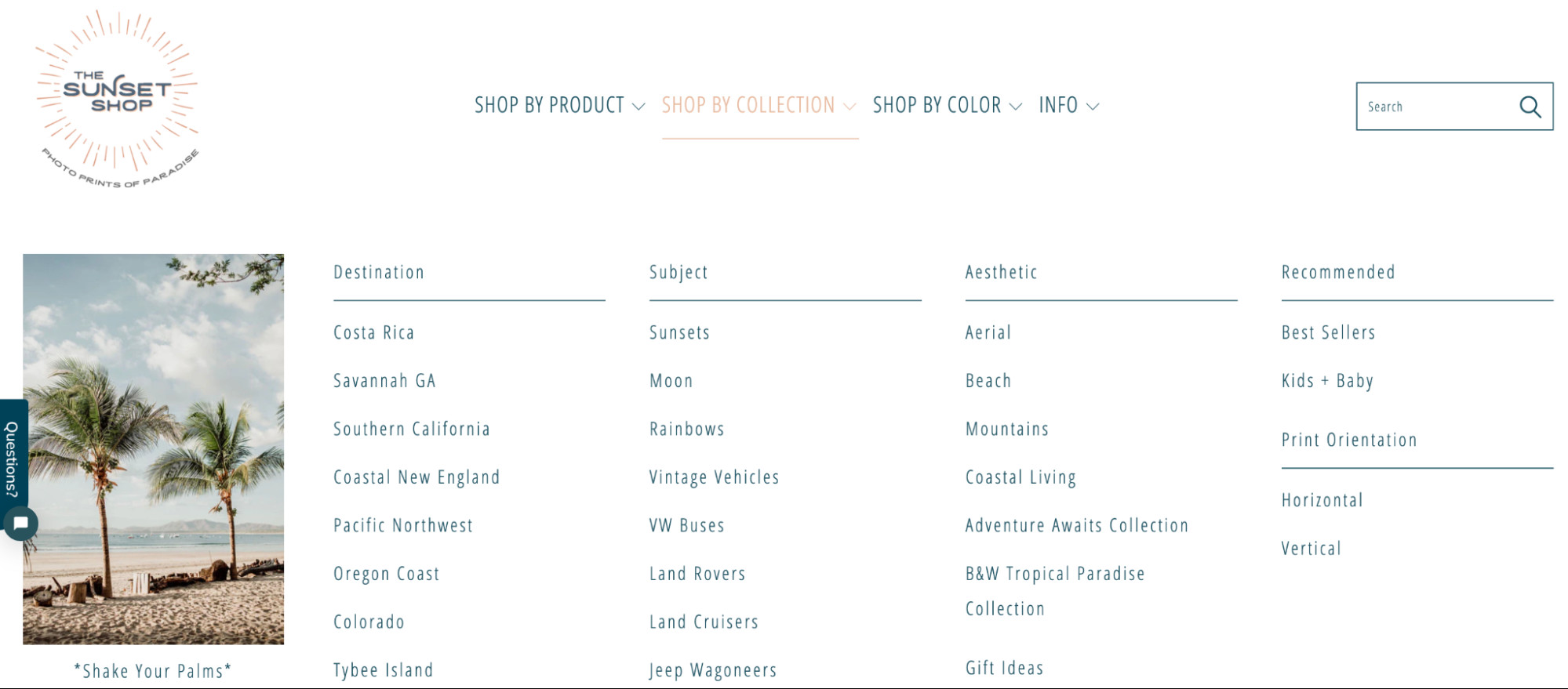 Example product categories on a photo print website.
Example product categories on a photo print website.
3. Optimize Images for the Web
Website speed is crucial. Optimize images for web performance:
- Compress Image Sizes: Reduce file size without significant quality loss. Aim for 60%-80% compression.
- Use Descriptive File Names: Instead of generic names like “IMG_1234.jpg,” use descriptive names like “golden-hour-beach-scene.jpg.”
- Write Alt Text: Add descriptive alt text to each image for SEO and accessibility.
4. Create a Compelling “About” Page
Personalize your portfolio with an “About” page. Share your photography journey, your passions, and what inspires you. This helps potential clients connect with you personally and builds your brand.
5. Implement E-commerce Functionality
Choose an e-commerce platform to handle sales logistics efficiently. Platforms like Shopify simplify:
- Building an online storefront.
- Selling on social media platforms.
- Processing payments and taxes.
- Managing digital or physical product delivery.
- Running marketing campaigns.
 Product page example for a 5×7 beach photo print.
Product page example for a 5×7 beach photo print.
6. Ensure Mobile Compatibility
With over half of web traffic coming from mobile devices, ensure your portfolio is mobile-friendly. Use responsive design, vertical image display, and finger-friendly buttons for optimal mobile viewing.
7. Launch and Promote Your Photos
Once your portfolio is ready, start promoting it using various marketing tactics:
- Share images on social media platforms.
- Use Pinterest to drive traffic to your site.
- Collaborate with influencers.
- Create behind-the-scenes content on platforms like TikTok and YouTube.
- Build an email list to engage visitors and offer promotions.
Expanding Your Sales: Prints and Photo Books
Beyond stock photos, consider selling physical products featuring your photography:
Selling Photos as Prints and Physical Products
Offer prints on paper, canvas, or merchandise like mugs, t-shirts, and calendars. Partner with local photo labs or use print-on-demand services to handle production and shipping. Always order samples to ensure product quality matches your photo quality.
Creating and Selling Photo Books
Photo books are another excellent product, especially if you specialize in a niche. Print-on-demand services offer a low-risk way to test demand before investing in larger print runs.
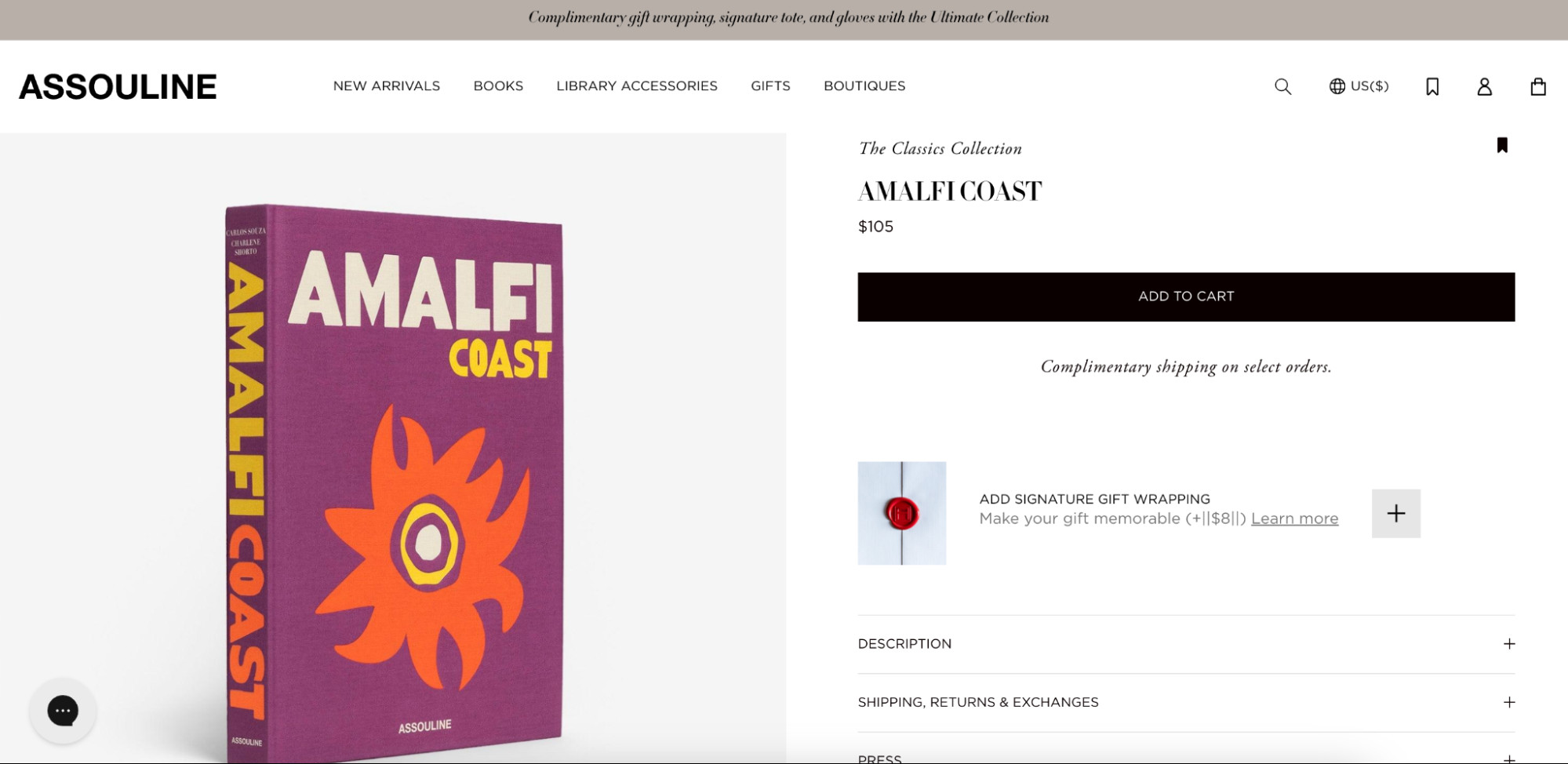 Example of a premium Amalfi Coast photobook.
Example of a premium Amalfi Coast photobook.
Offering Photography Services Online
Beyond product sales, selling your photography services is another revenue stream. List your services on freelance platforms like Fiverr and Upwork. Network locally and online to find clients for events, portraits, product photography, and more.
Networking tips:
- Carry business cards.
- Optimize your LinkedIn profile.
- Attend industry events.
- Build a strong personal brand on social media.
Use booking platforms like Setmore or SimplyBook.me, or scheduling apps for Shopify, to manage appointments and client bookings efficiently.
Pricing Strategies for Your Photography
Developing a solid pricing strategy is essential for profitability.
- Market Research: Understand what similar photos are selling for and what your target market is willing to pay.
- Profit Margins: Factor in your costs (equipment, website, marketing) to ensure profitable pricing.
- Usage-Based Pricing: Charge more for exclusive licenses than non-exclusive ones.
- Offer Discounts and Bundles: Use promotions to incentivize purchases and reward customer loyalty.
Legal Basics for Selling Photos Online
Understanding legal aspects is crucial for protecting your work and rights.
Glossary of Legal Terms:
- Editorial Use: For blogs, news, magazines.
- Commercial Use: For marketing and advertising.
- Retail Use: For physical products for sale.
- Exclusive Use: License granted to only one buyer.
- Non-Exclusive Use: License sold to multiple buyers.
- Public Domain: No copyright restrictions.
- Creative Commons: Conditional usage with stated restrictions, often requiring attribution.
- Royalty-Free: Unlimited use after license purchase.
- Rights-Managed: One-time license with use restrictions.
- Right of Publicity: Rights of individuals in photos, especially for commercial use; requires permission.
Protecting Your Photos from Theft
Watermarking your images is a key step to deter theft. Use watermarking tools in Photoshop or online watermark generators. If theft occurs, send a cease and desist letter or an invoice for unauthorized use. Always aim to get credit for your work, even for editorial uses, as backlinks improve SEO and drive traffic to your portfolio.
How to Sell Photos Online: FAQs
What is the best way to sell photographs online?
Selling stock photos on third-party websites like iStock, Shutterstock, and Alamy is often the quickest and most accessible way to start.
Where can I sell my photos online for money?
Top platforms include Alamy, 500px, Shutterstock, Getty Images, iStock, Stocksy, Picfair, Adobe Stock, Envato Elements, and Unsplash.
How do you make money from stock photography?
Stock photography websites act as agencies, licensing your uploaded images to clients. You receive royalty payments for each license sold.
Selling photos online offers a rewarding path to monetize your passion for photography. By understanding the platforms, implementing effective strategies, and protecting your rights, you can build a successful and sustainable online photography business.

